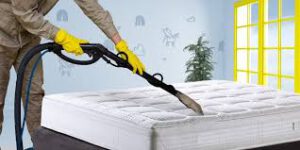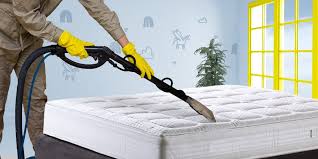When a mattress is stained, it’s important to clean it immediately to avoid the stain from setting. If the stains are biological — such as sweat, urine, or blood — Mattress Cleaning Perth cleaner is typically recommended.

Mix an enzyme cleaner with water and spray the soiled area. Let it sit and blot. Then sprinkle with baking soda and vacuum to remove the cleaner and odors.
In 24 hours, an average person sheds enough skin to feed a million dust mites. These microscopic bugs contribute to many gross diseases and thrive in warm, humid environments. Controlling them and other allergens requires a regular mattress vacuuming schedule.
Experts recommend vacuuming a mattress at least twice yearly (more often if someone in the household suffers from allergies). Take off the sheets and use the upholstery attachment on your vacuum cleaner to suck up bugs, feces, skin flakes, and other debris that tends to collect. Switch to the crevice tool to get into seams and other nooks and crannies. Also, remember to vacuum the carpeting around your bed and upholstered furniture nearby, as well as underneath your mattress.
Stains on a mattress can attract allergens, as well as create an unpleasant, musty odor. If your mattress has only mild stains, you can blot them with liquid laundry detergent diluted with water. For set-in stains, an enzyme cleaner like Oxiclean or a small amount of hydrogen peroxide may be all you need to remove them.
If you want to make a more thorough clean, consider hiring a professional cleaning service specializing in mattresses. Look for a national cleaning company that has established mattress sanitizing protocols and has experience with the type of mattresses you own. A reputable firm uses a hot water extraction system with a powerful wand that loosens soil, allergens, and odors and then vacuums up the trapped contaminants.
When the professionals have finished, you can speed up the drying process by taking your mattress outside and letting the sun do its work. A fan blowing across the mattress can help decrease drying time, too.
Baking soda is a household staple to clean your mattress and reduce unpleasant odors. Sprinkle a generous amount of baking soda over your mattress and let it sit for at least an hour to absorb any odors and moisture from the fabric. Then vacuum it thoroughly to remove the baking soda and leave your bed smelling fresh and clean.
Baking powder can also help you get rid of stains on your mattress. Mix equal parts baking soda and white vinegar in a spray bottle to create an effective cleaning solution for your mattress. Spray a light coating of the cleaner on your mattress and blot with a clean cloth to saturate any stubborn stains. Follow with a few more sprays and blots until the stain is removed. Then, sprinkle a light layer of baking soda over the mattress to neutralize any remaining odors and soak up any residual moisture from the vinegar.
If you have biological stains on your mattress, such as blood, sweat, or urine, use an enzyme cleaner to clean them. This type of cleaner kills germs and odor-causing bacteria while also deodorizing your mattress.
To keep your mattress smelling fresh between deep cleanings, you can use a scented linen spray to add a pleasant aroma to your bedding. Try one that contains calming scents, like lavender or chamomile, to help you relax before sleep.
When you’re ready to start your mattress cleaning routine again, vacuum it thoroughly to make sure you’ve removed all the dust and dirt that has accumulated. You can also use a sanitizing spray to kill bacteria and odor-causing germs. Look for a hospital-grade disinfectant to ensure a thorough cleaning and peace of mind while you sleep.
Keeping your mattress clean is essential for getting good rest. Regularly using a vacuum and baking soda will help you sleep better and prevent unwanted odors, stains, and bacteria from building up in your bed. Keeping up with your cleaning schedule will also help you extend the life of your mattress.
A common household item, white vinegar works well to remove stains and deodorize a mattress. Mix equal parts of water and white vinegar in a spray bottle, and apply the solution directly to the soiled areas of your mattress. Use a clean cloth to blot the area, avoiding rubbing, which will spread the stain. Let the cleaner sit for an hour, then vacuum it up. You can also sprinkle baking soda on your mattress to absorb odors and freshen it up. Allow the mattress to air dry, and pointing a fan toward the mattress can help promote faster drying times.
It’s important to remove all sheets, blankets, and pillowcases from your mattress prior to cleaning it. This allows you to focus on the areas that need it most. It’s also best to do this in a well-ventilated room so that the fumes from the vinegar don’t linger in the room.
Before tackling any staining, you should always try to get the area as dry as possible to prevent mold and mildew growth. You can use a microfiber cloth or sponge to blot the area until it is moisture-free. If you are unable to blot the stain, try using an enzyme cleaner or another type of biological stain remover.
Vinegar is a great deodorizer for mattresses, and it does a good job of eliminating sour urine smells. It’s important to note, however, that it cannot completely remove urine stains that have been there for long periods of time. If you are dealing with old urine stains, it is recommended that you use a stronger cleaning solution, such as a laundry detergent or hydrogen peroxide mixed with water.
Keeping your mattress clean is crucial for maintaining the health of your body and your mind. Regularly cleaning your mattress helps to reduce dust mites, bacteria, and other pollutants that can lead to allergies and asthma. Adding a mattress protector is another way to reduce allergens and odors in your bedroom while also protecting your investment. By following these simple steps, you can keep your mattress looking and smelling fresh for years.
When it comes to cleaning your mattress, hydrogen peroxide is one of the safest and most natural options. This is because it is a water-based solution, so it will not leave any toxic residue on your bed. It is also safe to use around children and pets. Furthermore, it is allowed in organic gardening and is effective against mildew and mold. Additionally, it is a great choice for those who suffer from allergies as it is a natural deodorizer and can help to eliminate odors.
Stains are one of the most common problems on a mattress. This can be due to bedwetting, sweat, blood, and even food stains. To get rid of these stains, first blot the area to soak up excess liquid. Then, make a cleaning solution with three parts water and 1 hydrogen peroxide. Pour this into a spray bottle and lightly spray the affected area of your mattress. Be careful not to saturate the area, as too much moisture can cause mold and mildew. After applying the solution, blot it dry with a clean cloth and allow the mattress to air dry. If possible, point a fan at the stain to speed up the process.
Once your mattress has been cleaned, you can use a vacuum cleaner with an upholstery attachment hose to remove any remaining dirt and dust. You should also rotate your mattress every three months to prevent sagging and lumps. Finally, consider leaving your mattress on a sunny day to let it air out. This will not only remove dead skin cells and dust mites, but it will also kill any bacteria that may be hiding in the mattress.
Using the tips above, you can keep your mattress clean and healthy throughout its life. However, it is important to note that these tips are not intended as a replacement for professional mattress cleaning. Professional mattress cleaning can damage your mattress by removing the natural fibers and filling materials. If you do want to use a professional service, then we recommend choosing one that offers green and organic cleaning methods.
